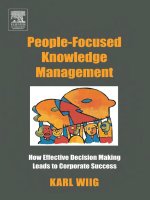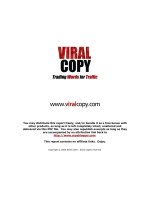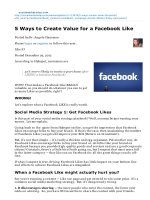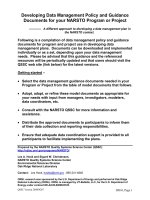Integrated management how sustainability creates value for any business
Bạn đang xem bản rút gọn của tài liệu. Xem và tải ngay bản đầy đủ của tài liệu tại đây (8.03 MB, 433 trang )
INTEGRATED
MANAGEMENT
“In an era when the severity of the problems of sustainability
are on the rise and the will to address them seems to be on
the wane, Robert Sroufe offers this valuable primer on integrated management. Within these pages, you will find practical tools to help any business leader make balanced decisions,
articulate an actionable vision and set his or her organization
on a long-term path towards addressing the great issues of
our day. This book gives hope that we can come to terms
with our sustainability challenges; indeed, if business does
not address these challenges we have little hope of solving
them.”
Andrew Hoffman, Holcim Professor of Sustainable Enterprise,
University of Michigan
“Integrated Management will be a valuable resource for any
manager or student interested in learning how to apply systems thinking to company sustainability. It clearly outlines a
path to real sustainability that all companies need to follow if
the world is to be a fit place for us humans in the future.”
Sandra Waddock, Galligan Chair of Strategy,
Boston College
“In an increasingly complex world, with growing environmental and social challenges, corporate strategy and management needs to change. Tackling big, systemic problems
requires working across normal lines in business. Integrated
Management offers solutions to a couple of long-standing and
related problems. Companies have too many functional silos,
and those divisions communicate and measure success in
only one language: cash, or financial capital. This book makes
an important argument and helps executives manage multiple
capitals beyond just the financial – human, intellectual, manufactured, social, and natural – and thus build more sustainable
and successful enterprises.”
Andrew Winston, Advisor to Multinationals &
Author of The Big Pivot and Green to Gold
“Meeting the challenge of sustainability will require strategies
and action from all segments of society: government, business, and citizens alike. Robert Sroufe advances the state of
the art by focusing in particular on the need to develop the
peripheral vision for integrating the many aspects of sustainability into a more coherent and effective business strategy.”
Daniel J. Fiorino, Director, Center for
Environmental Policy, American University
“To succeed as a business strategy, sustainability needs to be
baked-in across the enterprise, not bolted-on to one function:
this is the powerful idea that animates Robert Sroufe’s important new book. Providing concrete tools for integration practitioners as well as broad theoretical context for students,
Integrated Management will be a useful guide for those transforming business to meet the critical sustainability challenges
of the 21st century.”
Eban Goodstein, PhD, Director,
Bard MBA in Sustainability
“The most sustainable companies are those that have fully
integrated sustainability into their strategy, products, operations, and marketing. Drawing on best practices, this highly
accessible book describes why managers should drive such
integration, how to get the organization on board, and what
tools and concepts can help them achieve integration.”
Mike Toffel, Professor of Business Administration &
Faculty Chair, Business & Environment Initiative
“For too long social and environmental sustainability and
organizational growth and profitability have been seen at
odds. In Robert Sroufe’s new book he shows why and how
embedding sustainability in a company’s strategy and operations delivers real value for people, the planet and the bottom
line. The future of business will rely on this type of integrated
approach to sustainability and this book will provide practical
tools to ensure your business adapts and thrives in a changing
world.”
James Connelly, VP, Products and Strategic Growth,
International Living Future Institute
This page intentionally left blank
INTEGRATED
MANAGEMENT
How Sustainability Creates Value
For Any Business
BY
ROBERT P. SROUFE
Duquesne University, USA
United Kingdom À North America À Japan
India À Malaysia À China
Emerald Publishing Limited
Howard House, Wagon Lane, Bingley BD16 1WA, UK
First edition 2018
Copyright r 2018 Emerald Publishing Limited
Reprints and permissions service
Contact:
No part of this book may be reproduced, stored in a retrieval system, transmitted
in any form or by any means electronic, mechanical, photocopying, recording or
otherwise without either the prior written permission of the publisher or a licence
permitting restricted copying issued in the UK by The Copyright Licensing Agency
and in the USA by The Copyright Clearance Center. Any opinions expressed in the
chapters are those of the authors. Whilst Emerald makes every effort to ensure the
quality and accuracy of its content, Emerald makes no representation implied or
otherwise, as to the chapters’ suitability and application and disclaims any
warranties, express or implied, to their use.
British Library Cataloguing in Publication Data
A catalogue record for this book is available from the British Library
ISBN: 978-1-78714-562-7 (Print)
ISBN: 978-1-78714-561-0 (Online)
ISBN: 978-1-78714-975-5 (Epub)
ISOQAR certified
Management System,
awarded to Emerald
for adherence to
Environmental
standard
ISO 14001:2004.
Certificate Number 1985
ISO 14001
To Marybeth, Alexandra, and Isabella
vii
This page intentionally left blank
Contents
List of Figures
xiii
List of Tables
xvii
Foreword
xix
Preface
xxi
Acknowledgments
xxv
SECTION I
A DYNAMIC PERFORMANCE FRONTIER À BEYOND
SUSTAINABILITY
1.
The Integration Opportunity
We Need Decision-makers with a Vision for a Sustainable Future
Why Now?
A Dynamic Performance Frontier
Integration Operationalized
Trends À Evidence of the Inevitable
Chapter Summary
Bibliography
3
6
8
10
12
15
22
23
2.
Critical Dimensions of Integration À Enablers
Complex Problems
Systems Thinking
Value Creation
Change Management
Integrated Reporting À Evidence of Change
Chapter Summary
Bibliography
25
27
30
38
50
54
55
56
3.
A Customized Approach for Any Enterprise
Take an Action Learning Approach
Facilitation and the Strategic Planning Process
59
61
66
ix
Informed Decision-making
Integration and Change Management
Chapter Summary
Bibliography
76
78
79
80
SECTION II
BUILDING SHARED UNDERSTANDING
4.
5.
85
86
89
93
104
Integration Across Disciplines
Value Multiple Perspectives
Overcoming Obstacles À Functional Integration
Functional Integration
Enabling Integration Opportunities
Get the System in the Room À The Role of Boundary
Spanning Individuals
Chapter Summary
Bibliography
109
115
115
Value Creation for Stakeholders and Shareholders
More on Materiality
Shareholder Value
Making the Business Case
Chapter Summary
Bibliography
119
120
124
140
144
145
SECTION III
ASSESSING THE CURRENT REALITY (AS IS)
6.
7.
x
Design Thinking À Life Cycle Assessment
Invent À Test À Bring Integrated Management to Life
What’s Your Net Zero Strategy? (0Energy À 0Waste À 0Water)
Life Cycle Assessment À A Tool Supporting Design and
Goals of Zero
Overview of Life Cycle Assessment
Problem-based Learning (PBL) Application
Why and How LCA and Design Thinking Enable Integrated
Management À Outcomes
Your Ecological Footprint
Chapter Summary
Bibliography
151
152
156
Enterprise Systems À Operational and Strategic Assessment
Management Systems
Drives, Obstacles, and Enablers
181
182
187
C onten ts
162
163
170
172
176
177
179
Aligning Operating Systems: Strategic Frameworks for
Integration
Standards
Chapter Summary
Bibliography
193
199
203
206
SECTION IV
BRAINSTORMING ACTIONS TO CLOSE THE GAP (TO BE)
8.
The Changing Performance Frontier À Evolution and Trends
A Changing Performance Frontier À Materiality Map
Natural Capitalism
Cradle to Cradle
Industrial Ecology
Environmental Product Declarations and Living Products
High-performance Buildings
Chapter Summary
Bibliography
209
210
215
218
220
222
223
230
232
9.
Crossing the Chasm À Evidence and Opportunity
How Firms Integrate: Crossing the Chasm toward Sustainability
Crossing the Chasm
Social Cost of Carbon Dioxide
Carbon Disclosure Project and GHG Protocol
Global Reporting Initiative (GRI)
Integrated Reporting <IR> and IIRC
Impact Investing
Benefits Corporation
Chapter Summary
Bibliography
235
236
240
242
244
247
249
253
256
258
259
10. Propositions À Integration and Innovation
Integration and Innovation ÀPushing the Performance Frontier
Tools to Help Assess and Prioritize
Chapter Summary
Bibliography
261
262
272
274
276
SECTION V
PRIORITIZATION À ACTION
11. The Strategic Integrated Enterprises We Have Been Waiting for
Strategic Integrated Systems
Impacts of Corporations À Agents of Change
High-level Measurement and Alignment Options
Turn Options into Actions and Priorities À Goals for the Future
279
282
284
293
294
xi
Chapter Summary
Bibliography
12. The Future À What Could Be!
Revisiting the Performance Frontier
Challenges
We Need Innovative Decision-makers and Solutions
Strategies, Functions, Systems, Value Chains, and Cities are
Proving Grounds for Creative Solutions
A Call to Integrated Management Action
Optimism
Bibliography
308
309
311
315
316
319
320
326
329
331
Appendices
A. Integrated Management Resources Guide
Integrated Management Resources for Readers
The Framework for Strategic Sustainable Development
The More Comprehensive List of Resources by Topic Area
Notes
B.
Integrated Management Strategy Statement Appendices
(Actions You Can Take) from Chapter 3
Appendix 1 Examples of economic topics to review
Appendix 2 Examples of social topics to review
Appendix 3 Examples of societal topics to review
Appendix 4 Examples of environmental topics to review
Appendix 5 Examples of Sustainability Standards/Initiatives
367
368
369
372
373
376
391
Index
xii
335
335
335
338
350
Content s
List of Figures
Chapter 1
Figure 1.1:
The Performance Frontier. . . . . . . . . . . . . . . .
11
Figure 1.2:
Value-creation Process. . . . . . . . . . . . . . . . . .
14
Chapter 2
Figure 2.1:
Removing Barriers to Integration. . . . . . . . . . . .
34
Figure 2.2:
Levels of Cost Benefits. . . . . . . . . . . . . . . . . .
39
Figure 2.3:
Performance Dynamic. . . . . . . . . . . . . . . . . .
41
Figure 2.4:
The Interactive Components of the Business Model. .
43
Figure 2.5:
Integration and Organizational Change toward
Sustainability. . . . . . . . . . . . . . . . . . . . . . .
53
Chapter 3
Figure 3.1:
Integrated Management Planning using the ABCD
Procedure. . . . . . . . . . . . . . . . . . . . . . . . .
71
Chapter 4
Figure 4.1:
Multistakeholder Decision-making. . . . . . . . . . .
87
Figure 4.2:
Functional Symptoms vs Problems. . . . . . . . . . .
88
Figure 4.3:
Integration of Sustainability is Widespread. . . . . . .
92
Figure 4.4:
Sustainability’s Integration into Companies. . . . . . .
105
Figure 4.5:
Example Management Dashboards. . . . . . . . . . .
110
xiii
Chapter 5
Figure 5.1:
Conceptual Materiality Matrix. . . . . . . . . . . . . .
123
Figure 5.2:
Value Realization.. . . . . . . . . . . . . . . . . . . .
141
Chapter 6
Figure 6.1:
The Design Process and Outcomes. . . . . . . . . . .
155
Figure 6.2:
Sourcemap.com LCA Maps of Laptop Computer. . . .
163
Figure 6.3:
Overview of Life Cycle Elements, Emissions, and
Impacts. . . . . . . . . . . . . . . . . . . . . . . . . .
164
LCA Basic Principles: The Four-phased Approach. . .
169
Figure 6.4:
Chapter 7
Figure 7.1:
Important Attributes of Management Systems
Integration. . . . . . . . . . . . . . . . . . . . . . . .
188
Figure 7.2:
SWOT.. . . . . . . . . . . . . . . . . . . . . . . . . .
193
Figure 7.3:
GE McKinsey Matrix. . . . . . . . . . . . . . . . . . .
196
Figure 7.4:
Growth Share Matrix. . . . . . . . . . . . . . . . . . .
197
Figure 7.5:
Ansoff’s Matrix. . . . . . . . . . . . . . . . . . . . . .
198
Figure 7.6:
Porter’s Five Forces.. . . . . . . . . . . . . . . . . . .
198
Figure 7.7:
New Product Diffusion Curve. . . . . . . . . . . . . .
199
Figure 7.8:
Standards Review of Strategic Triangle. . . . . . . . .
202
Chapter 8
Figure 8.1:
Performance Frontier. . . . . . . . . . . . . . . . . . .
212
Figure 8.2:
SASB Materiality Map™. . . . . . . . . . . . . . . . .
213
Figure 8.3:
SASB Conceptual Framework Source. . . . . . . . . .
214
Chapter 9
Figure 9.1:
xiv
Integrated Management Adoption Cycle. . . . . . . .
List of Figu res
237
Chapter 10
Figure 10.1: Expanded Balance Sheet. . . . . . . . . . . . . . . . .
264
Figure 10.2: Investments Integrating Financial, Environmental, and
Social Cost-benefits.. . . . . . . . . . . . . . . . . . .
270
Chapter 11
Figure 11.1: The Funnel Metaphor. . . . . . . . . . . . . . . . . .
281
Figure 11.2: Forbes Rankings of Top Companies. . . . . . . . . . .
285
Figure 11.3: Newsweek Ranking of Top Companies. . . . . . . . . .
286
Figure 11.4: Corporations and Governments Revenues. . . . . . .
289
Figure 11.5: 100 Top Economies. . . . . . . . . . . . . . . . . . . .
290
Figure 11.6: Country-level Gap Frame Score and Priority
Dimensions. . . . . . . . . . . . . . . . . . . . . . . .
295
Figure 11.7: Sustainable Development Goals. . . . . . . . . . . . .
297
Figure 11.8: Starbucks’ Program Alignment across the SDGs. . . .
305
Figure 11.9: Global Regions Application of SDGs. . . . . . . . . .
307
xv
This page intentionally left blank
List of Tables
Chapter 4
Table 4.1:
Integration Goals in the Balanced Scorecard. .
107
GHG Protocol Emission Definitions. . . . . . .
247
Sustainable Development Goals with Examples.
298
Chapter 9
Table 9.1:
Chapter 11
Table 11.1:
xvii
This page intentionally left blank
Foreword
Every generation faces what they believe are unique and unprecedented
challenges. Today, we face a myriad of generational challenges. How do
we maintain economic growth? How do we make advances in medicine
widely available? How do we manage our scarce resources? How do we
make our workplaces more open to diversity of gender, ethnicity, and
life experience? How do we leverage data analytics, cloud computing,
and machine learning to improve the human condition?
Corporations have a significant role to play in meeting these challenges. However, they will not make long-term investments in intellectual and human capital to develop solutions to societal problems if
they focus on quarterly and annual earnings using backwards-looking
metrics.
Robert Sroufe has a vision that paints an exciting picture of what I
hope could be a change in the way organizations are managed and the
way business leaders make decisions. The concept of integrated management has begun to emerge within leading firms in different sectors.
Integrated management is a tool that can help the CEO share a vision for
the future, change a corporate culture, and develop a long-term strategy.
Integrated management is a process that helps an organization balance
the imperative to create long-term value À for shareholders and society À
with expectations for short-term competitiveness and profitability.
Integrated management is a way to consider the relationships between
environmental, social, governance, and financial performance when
making decisions. It drives creation of short- and medium-term metrics
that are explicitly linked to the long-term vision and strategy. It ensures
that sustainability is everyone’s responsibility rather than a standalone
function.
My work in integrated reporting has enabled me to meet with business leaders, investors, and non-governmental organizations all over the
world. In doing so, I have been fortunate to observe a few of the earliest
xix
applications of using integrated management systems to address global
challenges. While the challenges that confront our society are daunting, I
am inspired by companies that understand how integrated management
influences decisions and actions of management, shareowners, and other
stakeholders. The leaders of these organizations know that integrated
management is an essential element of governance and that it is critical
for investor confidence.
For the past ten years, Duquesne University, Robert Sroufe, and his
faculty colleagues have provided practical guidance, challenged perceptions, and discussed environmental, social and governance (ESG) materiality in their courses. I am optimistic about the future because Duquesne
University and other leading-edge MBA programs are helping future
generations of business leaders learn about the coming changes in business management as environmental, social, and governance performance
are fully integrated into business strategy.
I encourage you to read this book. If you are a business leader, it is an
important resource that provides a systems oriented, strategic approach
that can be applied to any company. If you are an analyst or investor, it
reinforces the necessity to ask C-level executives about their vision for
the future and how they will measure progress toward their long-term
objectives. If you are a member of civil society, it will help you understand how corporations can create value for current and future generations of shareholders.
Pablo Piccaso once said, “everything you can imagine is real.” While
it may seem like a stretch today, integrated management is great vision
to pursue. As you read this book, reflect not only on the actions available
to you to help make integrated management a generally accepted business practice, but also on the impact of those actions on your legacy.
Michael P. Krzus
Retired Partner, Grant Thornton LLP
xx
F o rew o r d
Preface
This book is for decision makers and lifelong students around the world
who want to integrate sustainability into business strategy and management practices. We take the view that sustainability is not something
that is to be done in addition to strategy; it is a part of strategy and leads
to dynamic performance improvement.
Motivations for writing this book came about from a need to have a
resource for students, researchers, and practitioners to quickly get up to
speed on the strategic opportunities sustainability provides within any
business. Opportunities include recognizing a global crisis of wasteful
systems, and changing business as usual. While climate change, social
unrest, high costs, and GHG emissions are symptoms, lack of integrated
decision making is the problem. There is no place for lack of awareness
and continued waste. Instead, there are growing opportunities across
business sectors and the supply chains that connect them to involve an
integrated approach to value creation, lower costs, the assessment of
ESG performance, and decision analysis. This approach promises new
insight as to how integrated decision-making processes up and down the
supply chain are possible for enterprises by leveraging evolving technical
resources (e.g., artificial intelligence, big data, dashboards, and
Blockchain) and cross-functional expertise to amplify the productivity of
everyday systems.
This book starts in Section I by suggesting there is a new vision of a
performance frontier beyond using the terminology of sustainability.
Integrated management provides the opportunity to rethink functions,
enterprises, and systems dynamics to reduce waste, to create value.
Critical drivers and enablers provide an enterprise, decision makers, and
policy maker’s ways to take on complex problems. As larger systems
level problems are addressed and disassembled into smaller systems
within systems, every enterprise can contribute to and have a vision
for their own sustainable future. With the application of a strategic
xxi
sustainable development framework, strategic planning, and backcasting
from your vision, readers will find integrated management opportunities
and manage change toward success.
While the first section of this book promotes awareness and a framework for strategic success, SectionII stresses the importance of building a
shared understanding of the integrated management opportunity across
enterprise functions. Given the importance of value creation in for-profit
enterprises, and a renewed energy in understanding value creation for
both shareholders and stakeholders, a review the importance of materiality in shareholder value, revenue growth, operating margins, asset efficiency, and expectations is necessary. The value creation opportunity
provides a transition into Section III and the importance of assessing and
benchmarking your current operating systems, processes, and strategic
assessment options.
Section IV then helps you to brainstorm actions to close the gap
between your current practices and a future state further out on the performance frontier. A review of best-practice trends and integrated practices prove you can close the gap. Finally, a number of propositions
provide a proving ground for a new measurement/management frontier
of integrated performance close out this section. Section IV provides a
path forward toward a new vision and change management. The final
chapters, Section V, moves a reader down this path in prioritizing integrated actions and goals for any enterprise that can lead to a regenerative
future. At the end of chapters, there are multiple opportunities to build on
a reader’s own research and application of problem based learning in previous chapters to help find creative solutions. This iterative process of
learning and application enables a reader to backcast from a selfdeveloped vision so that they can decide on their own priorities and goals.
Outcomes of this action learning approach help to assessing available
solutions to see how they can take any reader in the right direction toward
integrated management, are flexible, and have a business case for success.
Today’s solutions are social and technical. We have the technical feasibility, it’s already in place and it’s evolving. The social will to create new
norms involve systems thinking and analytics to tackle one of the biggest
opportunities of our time, “sustainable development.” Integrated management comes at that point in time when we realize the impacts of a
decision go well beyond a single functional perspective and can be measured across functions, firms, and value chains in multidimensional
ways.
To succeed with integrated management, a firm must ensure that this
outcome is not only present within an enterprise but is also present
xxii
Preface
within the supply chain. As the insights, evidence based practices, action
learning and concepts within this book will illustrate, the market and
consumers will punish those firms that promise ESG performance but
that are not able to deliver on this promise because of problems with a
lack of integrated management.
What we offer within this book are solutions, initiatives we would
want to achieve regardless of their proven positive impacts on a single
bottom line, as they are practices that benefit the environment and society in dynamic ways that for too long have been overlooked. To some
extent, we are all part of integrated enterprises and our role is to make
systems better by taking in new information, integrating the management of ESG performance in strategic planning, applying analytics, and
enabling better outcomes. What part of this multitrillion dollar integrated
management opportunity will you be part of?
The intent of this book is to be a standalone read for professionals, a
resource for executive education, and text for existing MBA strategic
sustainability and management courses. This information in this book
provides a multi perspective approach to integrated management opportunities across functions and value chains to allow understanding from a
variety of disciplines and professional backgrounds. If you are a business
professional wanting a 2- to 3-hour introduction to integrated management, we suggest you review Chapters 1, 2, 3, and 11 so you can more
quickly be ready to put learning into action, whether at the office or in
the classroom. For a more in-depth understanding of integrated management as a driver of value creation, we can’t help but recommend you
read each chapter and more fully engage in the research and actionlearning process explicitly positioned at the end of each chapter.
Features of this book include:
• How to strategically integrate management, ESG opportunities, and
planning activities;
• Evidence-based management examples from leading multinational
companies;
• Examples of innovative, cost saving integrated management trends
and best-practices;
• References to appropriate tools, emerging technology;
• Chapter research and action learning opportunities for the reader to
take a deeper look at integration management opportunities in their
own enterprise and supply chains;
xxiii
• Propositions for a new measurement/management frontier of integrated performance; and
• Application of concepts so that readers from any functional perspective will be able to see opportunities to implement and manage
integrated management practices that create value.
The opportunities outlined in this book are ultimately feasible by anyone with the propensity and motivation. The company examples, frameworks, methods, and action learning approach serve as a roadmap as
you navigate your own way across enterprises and interconnected systems to create your own vision and action plan for the future.
xxiv
P r e fa ce









